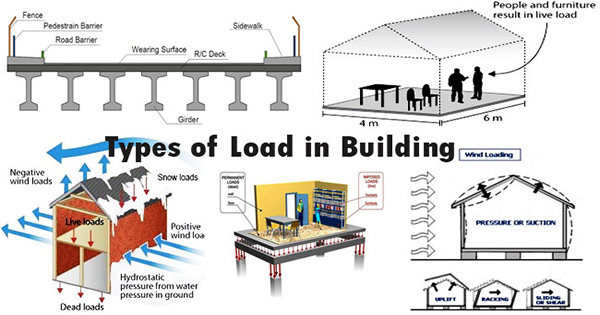Type of Loads Acting on a Structure and Building

The role of a structure is to frame specific materials and employ them in specific quantities to withstand different types of loads operating on it.
Structure is considered as the vital part of architecture that provides strength to a building to make resistance against the pull of earth and other loads operating on it.
Type of Loads
- Dead Load,
- Live Loads,
- Thermal & Settlement Loads,
- Dynamic Loads.
Dead Load: -The load of the structure solely is dead load; it comprises of the load of structural system (walls , columns, beams, space frame) cladding material (interior & exterior), Slabs, partition walls and weight of other permanent service equipment HVAC or Plumbing). The dimension of a structural element is influenced by the loads operating on it. The dead loads can be measured without any difficulty. Weight is assessed with consulting tables of Unit weights of structural material.
Live Load: -All other loads operating on a structure except dead loads is defined as live load. They contain all the movable weights ranging from human, furniture & fixtures and other non structural components like rain, snow & ice. The wind pressure, water pressure or push of earth is also contained in Live Load. Wind is treated as a very crucial load because of huge applications of lighter materials and more efficient building technologies. The wind load can’t be determined perfectly. Average wind velocities are identified to specific degree of Certainty. Aerodynamics tests on a model in a wind tunnel are carried on to determine the effect of a hurricane winds on skyscraper.
Thermal & Settlement Loads: - All building materials stretch or contract as per modification in temperature. Long continuous buildings will broaden, and it is required to take the expansion stresses into consideration. Expansion joints are arranged at these points to divide the structure physically and extend maintaining the structural integrity as it is. The other condition is to generate identical effects as of high loads, stems from an uneven settlement of the foundation of the building. The weak soli condition will decrease the support of the foundation. N supplementary load is employed to the building but because of uneven settlement, the supported portion of the building bears more loads.
Dynamic Loads: - When the Load fluctuates quickly or employed abruptly is known as dynamic loads. Proper consideration should be given to dynamic loads. The magnitude of a load is significantly raised with its dynamic effect.
Classification of Structural Systems
- Load Bearing Structures
- Frame Structure (Skeleton Structure) 1. Post & Lintel Structure 2. Simple & Multiple Frame Structure
- Compression & Tension Structure (Cables, Trusses, Space Frames)
- Membrane & thin Shell Structures
Load Bearing Construction: -In this type of construction each wall functions as a load carrying element. Earlier load bearing masonry construction was pecifically developed for large buildings. But, now-a-days, it is used for smaller residential-scale structures. It comprises of thick, heavy masonry walls of brick or stone that provide support to the whole structure along with the horizontal floor slabs formed with reinforced concrete, wood, or steel members.
Limitation of Load Bearing Structure: - It is not recommended for earthquake prone areas since several death incidents in earthquakes have happened in load bearing masonry buildings. It is totally labor-intensive and primarily constructed with masonry. The process is also very time consuming & slow. It is fully material-intensive. These types of buildings are built up with a lot of bricks, and are very weighty.

